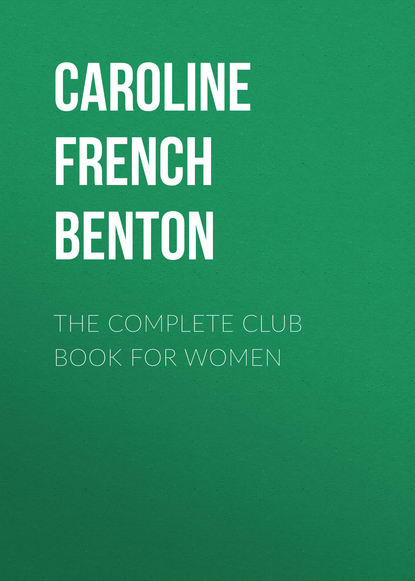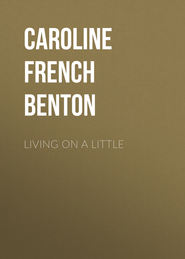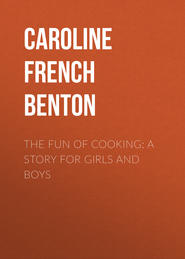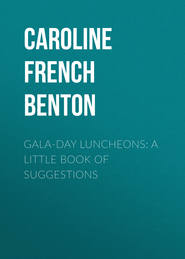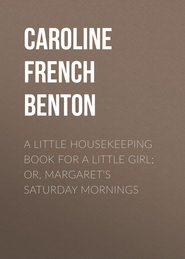По всем вопросам обращайтесь на: info@litportal.ru
(©) 2003-2024.
✖
The Complete Club Book for Women
Настройки чтения
Размер шрифта
Высота строк
Поля
III – NOVEMBER
Martin Luther, Schiller, Oliver Goldsmith and George Eliot all have birthdays to remember at this time.
Luther was the greatest of the Protestant Reformers, and has left his mark not only on Germany but on the whole world. Read of his early peasant life, his education, his career as priest and teacher. Then notice his trip to Rome and its results, and follow him through his struggles with Emperor and Pope. Discuss his work as a whole. Read from his Letters.
Schiller, the great German dramatist and poet, is honored and beloved both in his native land and elsewhere. Give the story of his struggles with poverty in exile, his love affairs, his professorship, his marriage and invalidism. Notice especially his friendship with Goethe. Read from his ballads, but especially from his dramas, "Die Jungfrau" and "Wilhelm Tell."
Oliver Goldsmith, the eccentric genius, poet, essayist, dramatist and novelist, should have special study, for he is a unique figure. Mention his school days, his vagabond pilgrimage through Europe, his work as a struggling hack writer; his remarkable friendships; read from "The Deserted Village," "The Vicar of Wakefield," and "She Stoops to Conquer."
The life and work of George Eliot are familiar to most club women, yet they are always a delightful study. Papers may tell of her home life and training as a free-thinker; of her translations, her marriage and its social consequences, and her work as writer. Read from "Scenes from Clerical Life," and from "Adam Bede." Discuss her philosophy, her moral purposes, her humor, her realism; have several readings from both prose and poetry.
IV – DECEMBER
The special meeting should be on the subject of the Christmas Birthday. Describe the Christmas customs in mediæval times, and read of the Yule log, the waits, the boar's head, and other customs, and show pictures of baronial halls. Have following papers on Christmas in various lands; one paper may be on the Christmas Spirit. Read from Christmas stories, and have carols sung.
V – JANUARY
There are four famous birthdays in January, those of Joan of Arc, Mozart, Molière, and Tennyson, illustrating history, music, drama and poetry.
Of late so much has been written of Joan of Arc that there is an abundance of material on her. Give a sketch of her personality, and show what she did. Read also appreciations from different writers. Show pictures of some of the statues of her, and, if possible, one of the picture by Bastien Lepage, called "Joan of Arc Listening to the Voices," in the Metropolitan Museum in New York.
Mozart was a child prodigy at six years and maintained his ability through a long life. Hampered, like most musicians, with poverty, he still had many friends, wrote excellent music, played at various courts and enjoyed a career full of interest, if not always of success. He died in poverty, and no one knows where he is buried. Show a copy of the well-known picture of him playing at court.
Molière, the great French dramatist, presents a study which should fill more than one meeting. Speak of his early life as a strolling player, his failure as a tragedian and his success in comedy. Sketch the stage of the period. Have scenes read from (translations of) "Tartuffe," "Le Misanthrope," and other plays. Compare him with other dramatists. (See his life by Chatfield-Taylor.)
Tennyson, the representative poet of the Victorian age, gives opportunity for a charming meeting. Sketch his calm, delightful life; show his interest in science and all modern ideas. Read from his ballads; his other short poems; his longer poems, especially "In Memoriam," the "Idylls of the King" and the "Dream of Fair Women," and compare them. If possible, sing some of his verses, many of which are set to music.
VI – FEBRUARY
Among many birthdays of famous men and women four may be chosen: those of Madame de Sévigné, Charles Lamb, Dickens and Mendelssohn.
Madame de Sévigné lived at a time when there were many conspicuous people at the court of Louis XIV, and she was the friend of them all; Turenne and Condé, however, may be especially noticed. Her fame rests on her Letters, which she wrote to her daughter with no idea any one else would ever see them. They have slight pretension to literary quality, yet they are among the classics of French literature. Have several selections from them read, illustrating the times and the court life.
Charles Lamb and his friends will make the subject of more than a single meeting. Give his life as a Blue Coat Boy and his early friendship with Coleridge at school. Speak of him as a clerk in the East India House, with his evenings at the Cat and Salutation. Tell of his family troubles and of his sister Mary; then of his literary career, his life in the Temple, his friendships with the Lake Poets and others. Notice the peculiar gentle charm which is associated with him. Read from his essays; give "Dream Children" as a whole.
Charles Dickens is a name to conjure with. Sketch his early life; read from many of his books, and point out his humor, pathos, tragedy, comedy, and realism; show his love of caricature and its place in his methods. He is called to-day The Prince of Story Tellers by well-known critics. Have each club member bring in and read her favorite passage from his books.
Mendelssohn stands alone among musicians, for he was born to a comfortable lot in life, was successful in whatever he undertook, happy in his home and renowned abroad. His relations with his sister, his position at the German courts, his various trips to England and what he accomplished there will furnish topics for papers. If he seldom touched the deeper side of life, yet what he gave was always good of its kind. Illustrate this program with many selections from both his instrumental and vocal music.
VII – MARCH
Michelangelo, and in later times Mrs. Browning, and our own William Dean Howells, were born in March.
Michelangelo was the most distinguished sculptor of the modern world, the most brilliant representative of the Italian Renaissance. Show the assistance Lorenzo the Magnificent gave art at this time. Notice Michelangelo's earlier work; speak of the curious way in which he, a sculptor, was compelled to paint the frescoes in the Sistine chapel; then how he became an architect, a builder of fortifications, a sculptor again, and finally the architect of St. Peter's. Show pictures of his best-known statues, and also of the frescoes.
Mrs. Browning is our best known and loved English woman poet. Her life is inseparable from that of her poet-husband, yet it has great individuality. Have papers on her early life, her marriage, her life in Florence and her work. Read from the "Sonnets from the Portuguese," addressed to her husband, from "Aurora Leigh" and from her shorter poems.
Howells is considered the most distinguished of our modern American prose writers, the leader of the realistic school which has so largely influenced recent work. He has written much besides his novels, but they are perhaps best known. Notice his ability to portray character; the delightful ease and naturalness of his style and his humor and truth in character drawing. Read from "The Rise of Silas Lapham," and "A Modern Instance." Read also from his sketches of travel.
VIII – APRIL
Study Hans Christian Andersen, Murillo, Wordsworth and Charlotte Brontë, whose birthdays come in this month.
Andersen's life is full of a simple interest, and a sketch of it may be followed by many readings from his books, especially from "A Picture-Book Without Pictures," "Tales for Children," and "The Ice Maiden." Notice that most of his work was illustrated from incidents from his own experience, which makes it natural.
Murillo, the Spanish painter, the friend of Velasquez, painted in three different styles, but he used only two classes of subjects; papers may work out this suggestion and illustrate it from his well-known pictures. Show copies of the "Assumption of the Virgin," his best-known religious work, and of others of the same style. Notice the beauty and charm of his children.
Wordsworth should certainly have more than one meeting given to him. Write of his quiet country life, of his wife and sister Dorothy; of his many friends; show his different styles of verse and read poems from each; read also his best-known sonnets.
Charlotte Brontë is one of the unusual English women writers. Write of her home life on the moors with her talented family, her work, especially "Jane Eyre," so full of striking romance, and her early death. Read several scenes from "Jane Eyre."
IX – MAY
Dante, Andubon, Browning and Brahms belong to May.
Dante's story, his life in Florence, his love for Beatrice, his military service, his exile and death all need plenty of time to study. His fame as a poet is unrivaled in its power and beauty of language. Have sketches of his life, his times and his work, and read what critics have said of it. Read also from translations of the "Vita Nuova" and the "Divina Commedia," in their translations. (See Longfellow's.)
The work of our own Audubon is better known to-day than when he was living. His life story is most romantic; read this, and show what he accomplished. Have shown some copies of his famous pictures of birds. Compare him with other naturalists.
Robert Browning did what no other poet has done; when he was twenty years old he found the theme for his life work, the development of the human soul; this is the key to his verse.
Read of his life in England and in Italy; speak of his friendships; study his philosophy; discuss his versification; show his different styles of work; have many illustrative readings. Compare him with other poets. Have some of his songs sung which are set to music; read also "Pippa Passes."
X – JUNE
Now come the birthdays of the musicians, Gounod and Schumann, and also of the patriot Nathan Hale, the teacher Thomas Arnold, and the novelist Thomas Hardy.
Hale is one of those men of whom we are always learning more. Have papers on his early life, his years at Yale, the events which led to his capture and his execution; show a picture of the statue in the City Hall Park of New York. Compare him with André. Give selections from different writers showing their estimate of him.
Thomas Arnold is the ideal for all teachers, and so an excellent subject for a meeting. Tell of his home; of Rugby as he found it; of his ideas for the school and for the individual boys; mention some of the great men he trained; read from "Tom Brown at Rugby" and show pictures of the school.
Hardy is one of the great Victorian novelists, a writer of somber, realistic and pessimistic stories of great power. Read of Wessex and its moors and wind-swept fells in the "Return of the Native." Notice the homely humor in all his books. Read from his most artistic work, "Far from the Madding Crowd," and from "Tess of the D'Urbervilles," his most dramatic. Compare him with other writers of the day. Discuss his philosophy.
CHAPTER XX
Programs from Clubs
I
A Virginia club has studied this group of painters:
Italian Artists: Raphael, Titian, Correggio.
Flemish Artists: Van Eyck, Rubens, Van Dyck.
Dutch Artists: Frans Hals, Rembrandt, Ruysdael.
Spanish Artists: Velasquez, Murillo, Fortuny.





